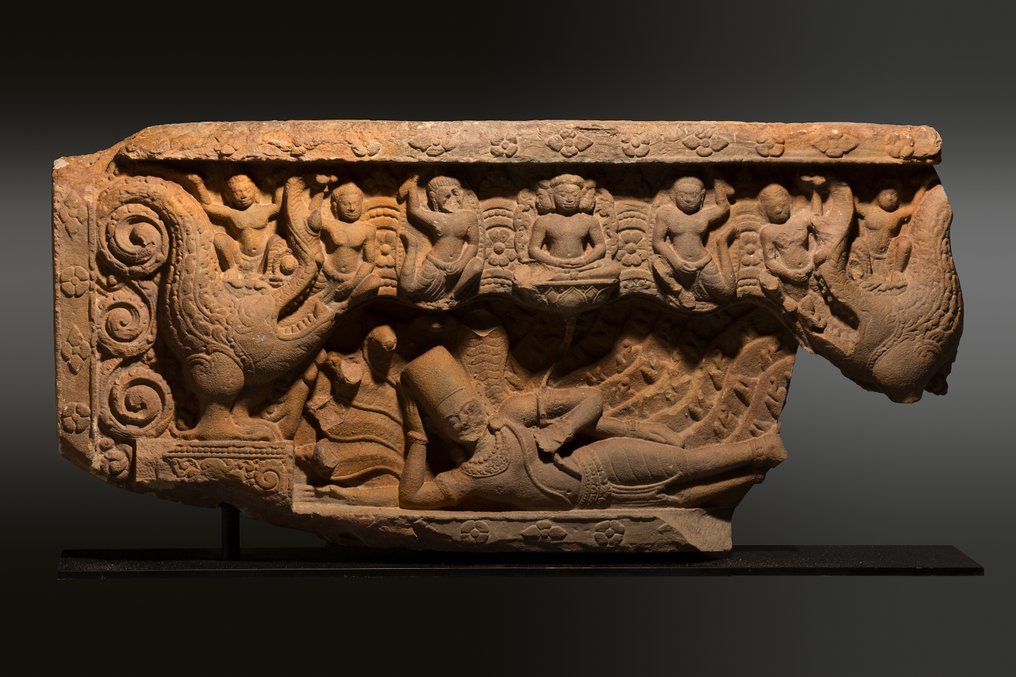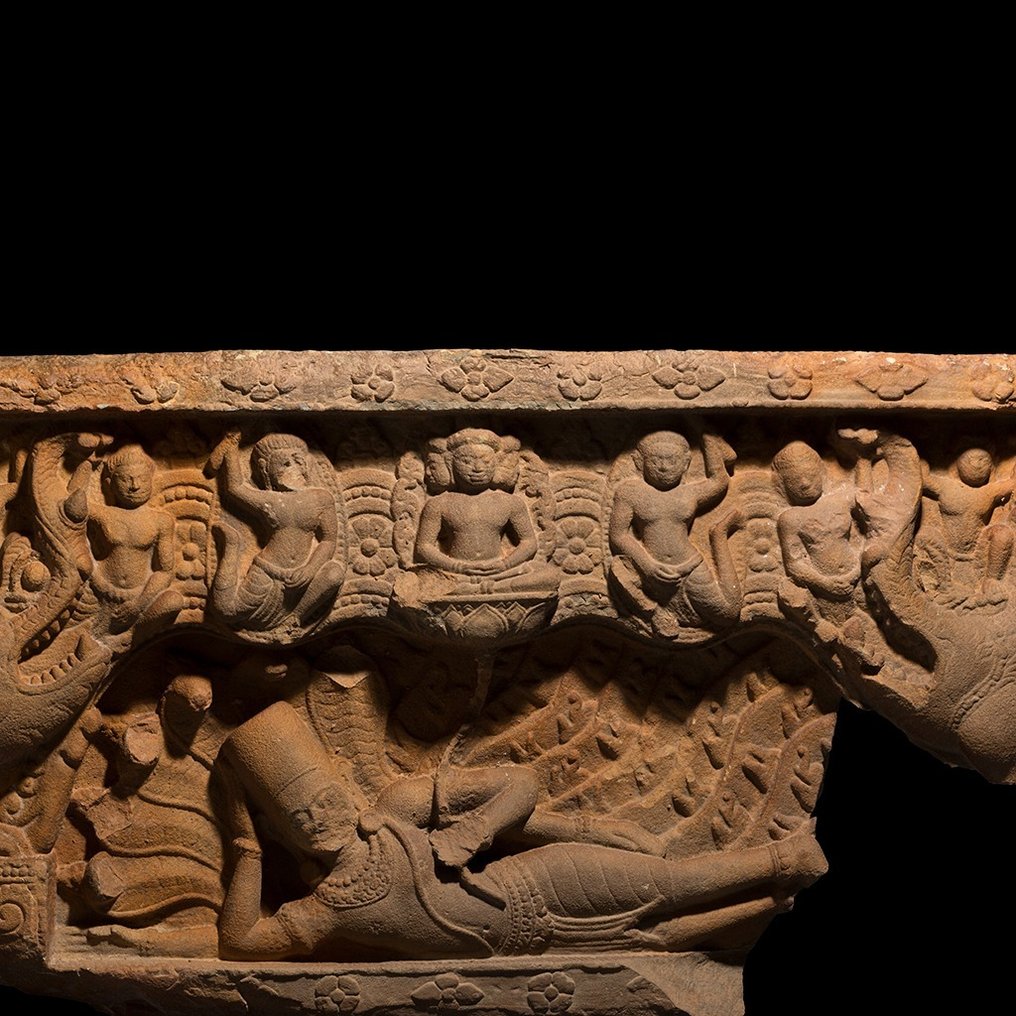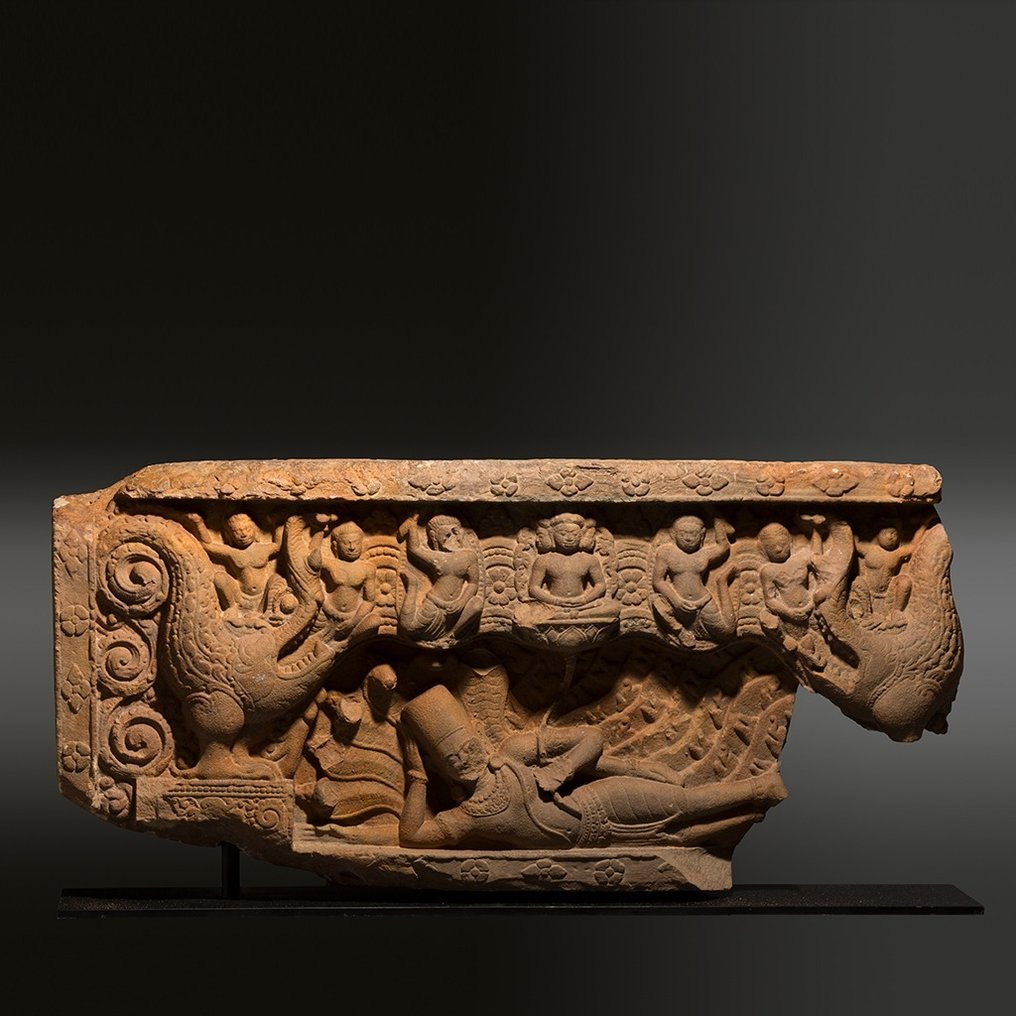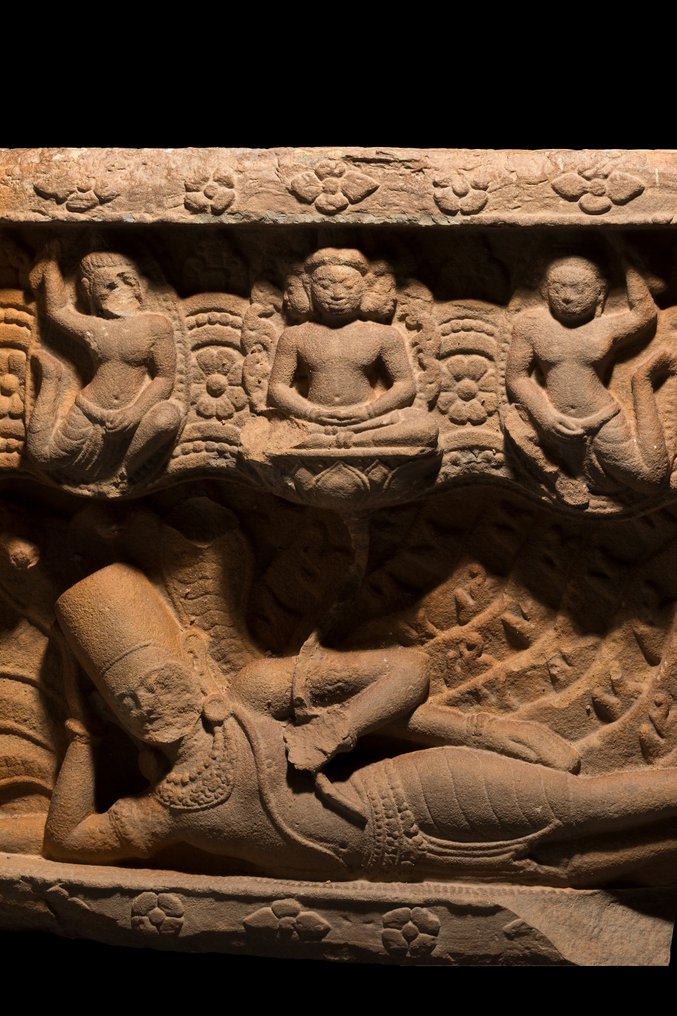Venditore eccellente. Articolo ben descritto e ben confezionato.
Vertaling bekijkenPre-Angkor, Cambodja Zandsteen Pre-Angkor, Cambodja Zandstenen latei met de droom van Vishnu en de geboorte van Brahma. 108 cm L.
Nr. 90344381





Lintel with the dream of Vishnu and the birth of Brahma
CULTURE: Pre-Angkor, Cambodia
PERIOD: Pre-Angkor period, end of 7th century - beginning of 8th century A.D.
MATERIAL: Sandstone
DIMENSIONS: 108 cm long and 51 cm high
PROVENANCE: Private collection, Asia, 1960.
CONSERVATION: Good condition, no restorations, except for the lack of the faces of some figures.
The chronological classification of Khmer monuments is essentially based on the study of architectural decoration. Following the work of Philippe Stern and Gilberte de Coral-Rémusat, who carried out a large number of studies, both through observations and detailed examinations, these works can be understood and classified. Pilasters and pediments, lintels and colonnades have evolved over the centuries at a variable rate, with some styles lasting a few decades and others, almost a century.
Lintels, when not reused from an earlier building, are arguably the most valuable chronological markers: each period in ancient Cambodian art is, in fact, remarkably different from earlier and later periods. The change from one style to another may occur gradually, as in the case of sculpture, in which case one speaks of evolution, or more radically, in which case one speaks of mutation.
The beautiful brick monuments belonging to the northern and southern groups of the ancient religious city of Sambor Prei Kuk are considered to be among the oldest Khmer temples still in existence (first half of the 7th century). Within this brick architecture, the door frames, lintels and columns were made of sandstone. They were clearly used to strengthen the buildings and, in some cases, have been the only elements that have been preserved.
In its composition, the more linear lintels are generally organized around a horizontal axis that marks the upper third of the area. It takes the form of a poly-lobed arch with vegetal motifs and beadwork, probably a stone copy of a wooden element.
The central scene that decorates this lintel, made in bas-relief, represents the dream of Vishnu and the birth of Brahma. Four-armed Vishnu is shown reclining on the mythical Naga, Ananta, whose six heads unfold to protect him. The god Brahma sits on an open lotus flower with a stem growing out of Vishnu's navel. He supports and holds the stem with his left hand. Four flying apsaras, two on each side, each wielding a mace with the outer arm, flank the image of Brahma. On each side of the central Vishnu scene is depicted a large makara with bird's feet and a three-spiraled tail, similar to the makaras on the 7th-century Prasat Dap lintel. A small figure emerges from the open jaws of each makara, like those on a 7th century lintel from Sambor Prei Kuk. By comparison with other lintels of similar iconography, one preserved in a U.S. collection and another at Tuol Ang in Kompong Speu, it can be deduced that tiny aquatic figures, such as the makara and the fish, would be shown emerging from raised, undulating panels representing water, just above the legs of Vishnu.
The dream of Vishnu, known as Vishnu Anantasayana, and the birth of Brahma were popular themes, frequently depicted on Khmer lintels during the 7th and early 8th centuries. The Vishnu in the present lintel wears a linked sampot can kpin, breastplate and belt, similar to those worn by the Vishnu image on the 7th century lintel of Tuol Baset. The belt is also similar to that worn by the Kimbell Museum Harihara (n.18). Vishnu is also adorned with bracelets, anklets, round earrings, and a sacred rope running from the left shoulder across his body. He wears a miter on his head that appears to be combined with a diadem.
The image of Vishnu Anantasayana was first depicted in India during the 5th century in Udayageri Cave 13. The pose of the Udayageri Vishnu is not the same as that of the images of Vishnu Anantasayana in Khmer sacred sculptures when it was first depicted in the 7th century. The basic image of Vishnu Anantasayana followed by Khmer artisans was not formulated in ancient India until the 6th century. A late Gupta period example at Deogarh in which Vishnu is adorned with a breastplate, belt, earrings and diadem, shows the same type of ornaments used by Vishnu in this lintel. A 7th-8th century gilt-bronze Srivijaya ornament found at Muang Pra Wiang, Nakhon Si Thammarat, in mainland Thailand, depicts a makara that is very similar to the one depicted here.
BIBLIOGRAPHY:
- Sculpture of Angkor and Ancient Cambodia: Millennium of Glory. Thames & Hudson. 1997. pp. 166-167.
- BUNKER, E. y LATCHFORD, D. Adoration and Glory. The Golden Age of Khmer Art. Art Media Resources Ltd. 2003. pp. 84 – 85.
- DAGENS, B. y DALSHEIMER, N. Les collections du musée national de Phnom Penh, l’art du Cambodge ancient. École Française d’Extreme-Orient. 2001. pp. 183, 184, 187, 192, 193.
Notes:
- The piece includes authenticity certificate.
- The piece includes Spanish Export License (Passport for European Union). NOT TAXES.
- According to Spanish legislation, items sent outside the European Union are subject to export taxes and will be added to the invoice, at the buyer's expense. These export fees are fixed on the final auction price and the tax rate is not applied directly on the total value of the item to be exported, but rather the different percentages by sections are applied to it:
- Up to 6,000 euros: 5%.
- From 6.001 to 60.000 euros: 10%.
This export permit application process can take between 1-2 months maximum.
- The seller guarantees that he acquired this piece according to all national and international laws related to the ownership of cultural property. Provenance statement seen by Catawiki.
#MasterpiecesW39
De verkoper stelt zich voor
Lintel with the dream of Vishnu and the birth of Brahma
CULTURE: Pre-Angkor, Cambodia
PERIOD: Pre-Angkor period, end of 7th century - beginning of 8th century A.D.
MATERIAL: Sandstone
DIMENSIONS: 108 cm long and 51 cm high
PROVENANCE: Private collection, Asia, 1960.
CONSERVATION: Good condition, no restorations, except for the lack of the faces of some figures.
The chronological classification of Khmer monuments is essentially based on the study of architectural decoration. Following the work of Philippe Stern and Gilberte de Coral-Rémusat, who carried out a large number of studies, both through observations and detailed examinations, these works can be understood and classified. Pilasters and pediments, lintels and colonnades have evolved over the centuries at a variable rate, with some styles lasting a few decades and others, almost a century.
Lintels, when not reused from an earlier building, are arguably the most valuable chronological markers: each period in ancient Cambodian art is, in fact, remarkably different from earlier and later periods. The change from one style to another may occur gradually, as in the case of sculpture, in which case one speaks of evolution, or more radically, in which case one speaks of mutation.
The beautiful brick monuments belonging to the northern and southern groups of the ancient religious city of Sambor Prei Kuk are considered to be among the oldest Khmer temples still in existence (first half of the 7th century). Within this brick architecture, the door frames, lintels and columns were made of sandstone. They were clearly used to strengthen the buildings and, in some cases, have been the only elements that have been preserved.
In its composition, the more linear lintels are generally organized around a horizontal axis that marks the upper third of the area. It takes the form of a poly-lobed arch with vegetal motifs and beadwork, probably a stone copy of a wooden element.
The central scene that decorates this lintel, made in bas-relief, represents the dream of Vishnu and the birth of Brahma. Four-armed Vishnu is shown reclining on the mythical Naga, Ananta, whose six heads unfold to protect him. The god Brahma sits on an open lotus flower with a stem growing out of Vishnu's navel. He supports and holds the stem with his left hand. Four flying apsaras, two on each side, each wielding a mace with the outer arm, flank the image of Brahma. On each side of the central Vishnu scene is depicted a large makara with bird's feet and a three-spiraled tail, similar to the makaras on the 7th-century Prasat Dap lintel. A small figure emerges from the open jaws of each makara, like those on a 7th century lintel from Sambor Prei Kuk. By comparison with other lintels of similar iconography, one preserved in a U.S. collection and another at Tuol Ang in Kompong Speu, it can be deduced that tiny aquatic figures, such as the makara and the fish, would be shown emerging from raised, undulating panels representing water, just above the legs of Vishnu.
The dream of Vishnu, known as Vishnu Anantasayana, and the birth of Brahma were popular themes, frequently depicted on Khmer lintels during the 7th and early 8th centuries. The Vishnu in the present lintel wears a linked sampot can kpin, breastplate and belt, similar to those worn by the Vishnu image on the 7th century lintel of Tuol Baset. The belt is also similar to that worn by the Kimbell Museum Harihara (n.18). Vishnu is also adorned with bracelets, anklets, round earrings, and a sacred rope running from the left shoulder across his body. He wears a miter on his head that appears to be combined with a diadem.
The image of Vishnu Anantasayana was first depicted in India during the 5th century in Udayageri Cave 13. The pose of the Udayageri Vishnu is not the same as that of the images of Vishnu Anantasayana in Khmer sacred sculptures when it was first depicted in the 7th century. The basic image of Vishnu Anantasayana followed by Khmer artisans was not formulated in ancient India until the 6th century. A late Gupta period example at Deogarh in which Vishnu is adorned with a breastplate, belt, earrings and diadem, shows the same type of ornaments used by Vishnu in this lintel. A 7th-8th century gilt-bronze Srivijaya ornament found at Muang Pra Wiang, Nakhon Si Thammarat, in mainland Thailand, depicts a makara that is very similar to the one depicted here.
BIBLIOGRAPHY:
- Sculpture of Angkor and Ancient Cambodia: Millennium of Glory. Thames & Hudson. 1997. pp. 166-167.
- BUNKER, E. y LATCHFORD, D. Adoration and Glory. The Golden Age of Khmer Art. Art Media Resources Ltd. 2003. pp. 84 – 85.
- DAGENS, B. y DALSHEIMER, N. Les collections du musée national de Phnom Penh, l’art du Cambodge ancient. École Française d’Extreme-Orient. 2001. pp. 183, 184, 187, 192, 193.
Notes:
- The piece includes authenticity certificate.
- The piece includes Spanish Export License (Passport for European Union). NOT TAXES.
- According to Spanish legislation, items sent outside the European Union are subject to export taxes and will be added to the invoice, at the buyer's expense. These export fees are fixed on the final auction price and the tax rate is not applied directly on the total value of the item to be exported, but rather the different percentages by sections are applied to it:
- Up to 6,000 euros: 5%.
- From 6.001 to 60.000 euros: 10%.
This export permit application process can take between 1-2 months maximum.
- The seller guarantees that he acquired this piece according to all national and international laws related to the ownership of cultural property. Provenance statement seen by Catawiki.
#MasterpiecesW39
De verkoper stelt zich voor
- 818
- 9
- 2
I'm absolutely happy with my purchase. The object is wonderful. Object as described, delivery was really fast
Vertaling bekijkentop 💯💯💯💯💯💯 come sempre :-)
Vertaling bekijkenmatches with photos, excellent packaging, very quick delivery
Vertaling bekijkenThe lamp is very beautiful and is in excellent condition. Professional packaging, complete documentation, very fast shipping. Thank you!
Vertaling bekijkenA smooth transaction! Thank you!
Vertaling bekijkenottimo venditore - fantastico oggetto
Vertaling bekijkenLivraison rapide et lot très bien emballé.
Vertaling bekijkenVery good
Vertaling bekijkenTout est parfait
Vertaling bekijkenVery quick shipment / excellent packaging / all the documents are inside. All very good 👍👏 Congrats and thank you !
Vertaling bekijkenTodo perfecto
Vertaling bekijkenWare sicher verpackt und schnell verschickt. Alles bestens!
Vertaling bekijkenMuy buenos siempre … Bagot siempre es de confianza.
Vertaling bekijkenI am really pleased with my purchase it's really lovely. It's beauty and quality exceed my expectations. The object was well wrapped and packed.
Vertaling bekijkenGisteren niet ontvangen normal hebben ze mijn handtekening nodig doch lag bij de gebeuren ,eind goeg al goed😃😊
Vertaling bekijkenbellissima ciotola etrusca top 💯💯💯💯💯💯💯💯 grazie :-)
Vertaling bekijkenTodo bien
Vertaling bekijkenMuy bien todo. Gracias
Vertaling bekijkenPerfect
Vertaling bekijkenThank you, everything was perfect!
Vertaling bekijkenpiezas muy interesantes. Todo muy correcto, como siempre.
Vertaling bekijkenestoy muy agradecida por como han tenido tanto tacto y cuidado en enviar la figura protegida, su certificado de autenticidad es muy profesional, al igual que su atención y trato con el cliente
Vertaling bekijkenEl vendedor cumple lo prometido, el objeto es de alta calidad, entonces estoy muy satisfecho con mi compra, muchas gracias.
Vertaling bekijken- 818
- 9
- 2
Venditore eccellente. Articolo ben descritto e ben confezionato.
Vertaling bekijkenDisclaimer
De verkoper garandeert dat het object legaal is verkregen en kan dit bewijzen. Catawiki heeft de verkoper geïnformeerd dat hij/zij documentatie moet overleggen die vereist is volgens de wetten in hun land van verblijf. De verkoper garandeert dat hij/zij toestemming heeft om het object te verkopen/exporteren. De verkoper zal alle over het object bekende herkomstgegevens aan de koper verstrekken. De verkoper zorgt ervoor dat eventueel benodigde vergunningen zijn/zullen worden geregeld. De verkoper zal de koper onmiddellijk informeren over eventuele vertragingen bij het verkrijgen van dergelijke vergunningen.
De verkoper garandeert dat het object legaal is verkregen en kan dit bewijzen. Catawiki heeft de verkoper geïnformeerd dat hij/zij documentatie moet overleggen die vereist is volgens de wetten in hun land van verblijf. De verkoper garandeert dat hij/zij toestemming heeft om het object te verkopen/exporteren. De verkoper zal alle over het object bekende herkomstgegevens aan de koper verstrekken. De verkoper zorgt ervoor dat eventueel benodigde vergunningen zijn/zullen worden geregeld. De verkoper zal de koper onmiddellijk informeren over eventuele vertragingen bij het verkrijgen van dergelijke vergunningen.